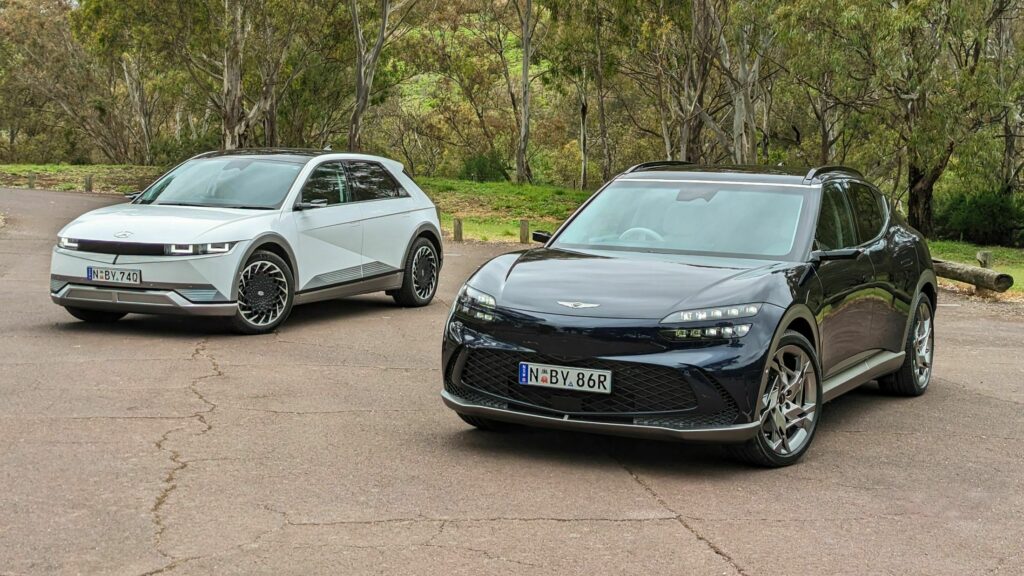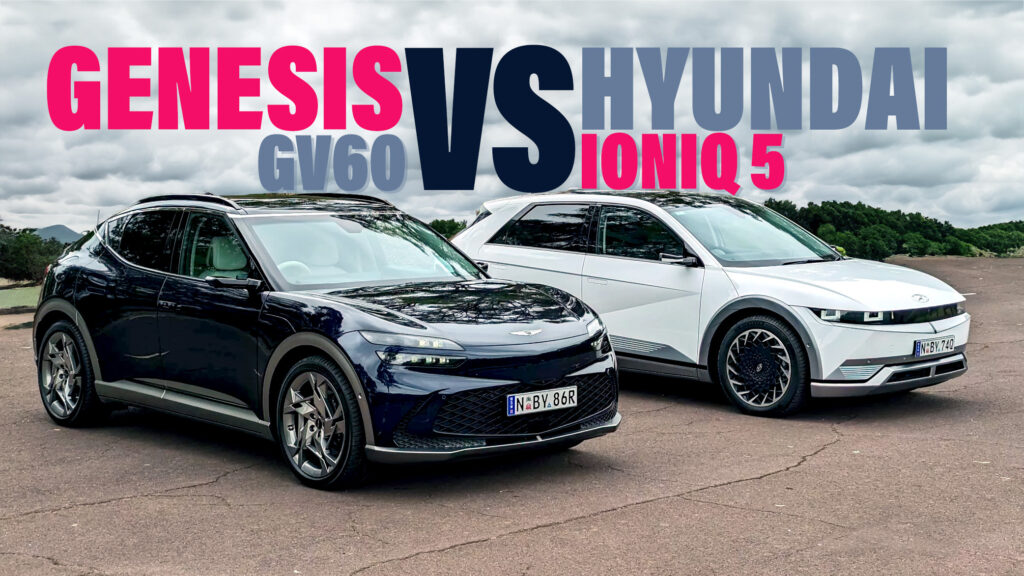Genesis is the premium brand of the Hyundai Group, positioned above Hyundai and Kia in terms of pricing. While the differentiation is evident in most vehicle segments, we were curious whether it extends to their mechanically related EVs. Hyundai Australia provided us with the keys to a Genesis GV60 Performance AWD and a Hyundai Ioniq 5 Epiq AWD, enabling a direct comparison between the two.
Both press cars represent the flagship trims of their respective lineups (excluding the Hyundai Ioniq 5 N), ensuring a fair comparison. As you’ll observe in the chart below, although the electric crossovers share the same underpinnings and some components, they boast slightly different specs.
More: The Hyundai Ioniq 5 N Is A Ballistic Missile That Redefines EVs
Before we move on, we should note that Hyundai has already announced the facelifted Ioniq 5, and an updated version of the GV60 is expected to follow later this year. Still, none of these are currently available in the market.
QUICK FACTS
And now we covered the basics, let’s dive deeper into the strengths and weaknesses of each model when you drive and experience them side by side.
Design: The Hyundai Looks Sharper, But The Genesis Outshines It In The Flesh
Photos Thanos Pappas / CarScoops
Starting with the exterior, the designers of Hyundai and Genesis succeeded in giving each EV a distinct character. Size-wise they’re similar, with the Hyundai being 120 mm (4.7 inches) longer and only 10 mm (0.4 inch) taller. However, the styling language is completely different – the Ioniq 5 has a retro-futuristic stance with straight lines and geometric shapes, while the GV60 is curvier and has a sloping roofline at the back. Overall, the Hyundai looks like an oversized hatchback from the future, while the Genesis is closer to the modern coupe-SUV archetype.
I’ll admit that I prefer the looks of the Hyundai – especially on the rear – but the Genesis GV60 turns more heads and looks more expensive in person, despite being less photogenic from certain angles. The Capri Blue shade and the 21-inch wheels of the press car added to its charisma, compared to the more humble white shade and 20-inch wheels of the Hyundai. Both EVs have flashy mirror-replacing cameras, panoramic sunroofs, and full-LED lighting all around. However, the Bentley-style badge of the Genesis sends superior vibes compared to the familiar and trustworthy Hyundai emblem.
What we can say about the future is that the upcoming mid-lifecycle updates on both EVs will improve their styling. The 2025 Hyundai Ioniq 5 adopted a cleaner design for the bumpers, something that was also suggested by the leaked photos of the 2025 Genesis GV60.
Interior: Genesis Has The Upper Hand In Luxury, Hyundai Offers More Space
Photos Thanos Pappas / CarScoops
Moving inside, it is a lot easier to tell which is the most expensive of the two. The light-colored Ash Grey and Glacier White interior of the Genesis GV60 (a no-cost option) is by far the most luxurious and inviting, with the dark-themed cabin of the Hyundai Ioniq 5 looking bland in comparison.
The quality is top notch and the GV60 feels more like a luxury flagship rather than a compact crossover. The quilted Nappa leather upholstery on the seats, the suede door cards, and the metal inserts are superior to the Hyundai’s eco-processed leather, soft-touch plastics, and tile-style patterns. The same applies to the rotating sphere-shaped gearbox shifter of the Genesis which proved to be more intuitive than the shift stick of the Hyundai.
The technology is largely shared between the two EVs, including the dual 12.3-inch screen layout of the digital cockpit, the head-up display, and the smaller screens on the sides showing feed from the mirror-replacing cameras. The latter makes for a great conversation starter but performs worse than conventional mirrors in terms of depth perception. I also experienced the post-rain foggy camera issue reported by Hyundai Ioniq 5 owners which was solved after a few minutes of exposure to direct sunlight.
More: 2025 Genesis G80 Combines Sportier Styling With Tech-Focused Interior
Photos Thanos Pappas / CarScoops
Back to our comparison, the configurable digital instrument cluster of the Genesis looks cooler than the one in the Hyundai thanks to its ability to show live feed from the forward camera, infused with navigation-related graphics. Both infotainments look crisp and are easy to use, so it’s a matter of personal taste if you prefer the more traditional grid layout of the Hyundai or the horizontal sliding structure of the Genesis.
What I didn’t like in the Hyundai is that the controls for the heated and ventilated seats were hidden inside menus, making them much harder to find than the dedicated buttons on the center console of the Genesis. Thankfully, Hyundai fixed this issue in the facelifted Ioniq 5, together with the welcome addition of a rear wiper. The climate controls are always within reach in both EVs, but they look and perform better in the Genesis thanks to the extra display and the regular buttons (Hyundai opted for touch-sensitive controls).
Review: The 2022 Hyundai Ioniq 5 Is Better Than The Tesla Model 3
In terms of equipment, the Hyundai Ioniq 5 Epiq AWD comes packed with features as expected from a flagship trim level. The only notable exception is the lack of wireless Android Auto / Apple CarPlay connectivity (wired only), which is also absent from the Genesis. Hopefully, both automakers will add wireless connectivity on the facelifted versions of the EVs, as they can’t miss out on something that comes standard in the much-cheaper Hyundai Kona.
As for safety, both come standard with the latest advancements in driver assistance, including sophisticated ADAS and a cool remote parking function.
Photos Thanos Pappas / CarScoops
Predictably, the Genesis has a few features that are missing from the Hyundai. The highlights are the massaging driver’s seat which proved to be a nice treat on longer journeys, the USB-C ports (instead of USB-A), and an exceptional sound system. Hyundai’s 8-speaker Bose audio delivers wonderful quality, but it can’t compare with the immersive 17-speaker Bang & Olufsen sound system of the Genesis which makes you feel like you’re in a concert hall.
As much as I enjoyed the amenities of the Genesis I will admit that the Hyundai had a more spacious cabin. Benefiting from the extra 100 mm (3.9 inches) in its wheelbase, the sliding rear bench, and the straight roofline, the Ioniq 5 beats the GV60 in terms of rear legroom and headroom. I am 6.04 foot (1.84 m) tall and felt comfortable in the backseat of the Hyundai, while in the Genesis my head was touching the roof. Note that both models came with the panoramic sunroof option which was slightly larger in the Hyundai and more heavily tinted in the Genesis.
More: Can This EV Park Better Than You? Genesis GV60’s Remote Parking Trick Tested
In terms of boot space, the Hyundai takes the victory with 527 lt (18.6 cubic feet) compared to the modest 432 lt (15.3 cubic feet) of the GV60. However, in-cabin storage is slightly better in the Genesis, thanks to the larger cubbies and the extra pair of cupholders mounted on the rear doors.
Performance: Both Are Very Quick But The Genesis Is Faster And Smoother
Photos Thanos Pappas / CarScoops
Based on the same E-GMP architecture, the standard RWD and AWD extended-range trims of the Hyundai Ioniq 5 mirror the specs of the equivalent Genesis GV60. However, the Performance trim of the latter adds a Boost function, a rear limited slip differential (E-LSD), and an adaptive electronically controlled suspension with predictive features.
The first thing you notice when you drive the EV siblings side by side is the more refined ride of the Genesis which is also quieter thanks to the superior sound insulation. The adaptive suspension feels softer over bumps and better composed under pressure, while the steering feels slightly more direct. As a result, the Genesis is a more comfortable cruiser than the Hyundai and at the same time, it has sharper driving dynamics. Unlike other adaptive suspensions, the difference in the chassis setup between driving modes (Eco, Comfort, and Sport) is barely noticeable, but the car responds well to any driving style.
The power delivery in the RWD-only Eco mode of both vehicles is far more restrained than in the AWD-enabled Sport mode, with the Comfort (Genesis) and Normal (Hyundai) settings playing the role of an all-rounder.
What really makes a difference though is the “Boost” button on the steering wheel of the Genesis which unlocks the full 483 hp (360 kW / 490 PS) and 700 Nm (516 lb-ft of torque) for 10 seconds. During this time, the GV60 feels much quicker than the Ioniq 5, which is already a very fast and capable EV. Without the Boost fuction, the GV60 makes 314 hp (234 kW / 318 PS) which is incrementally less than the 321 hp (239 kW / 325 PS) of the Hyundai, meaning that you don’t really notice any difference in everyday life.
More: Kia And Hyundai’s Active Air Skirt Boosts EV Range And Performance
Photos Thanos Pappas / CarScoops
The roller-coaster-style acceleration is so fun that I found myself pressing the “Boost” button quite often. As a result, the real-life driving range figures I achieved with the Genesis were inferior to those with the Hyundai. However, even with the higher energy consumption caused by my spirited driving bursts, the GV60 could easily do 250 miles (400 km) between charges, which was around 30 miles (50 km) less than what my calmer self did with the Ioniq 5.
The models share the same 77.4 kWh battery pack which can go from 10 to 80 percent in around 18 minutes when plugged into an ultra-fast charger. Note that the 350 kW DC maximum charging rate of the Hyundai / Genesis duo outperforms rival such as the Tesla Model Y and VW ID.4.
Verdict: The Genesis GV60 Is Worth The Extra Money If You Care About Luxury

I’ll admit that when I organized his comparison I thought it would be hard to justify the AU$29,500 (US$19,361) price premium of the Genesis GV60 Performance AWD compared to the Hyundai Ioniq 5 Epiq AWD (the price difference between the equivalent US-spec models is around $10,000). However, after spending two weeks with each car I fully understood the meaning of luxury and the added value it brings to a product.
Don’t get me wrong, the Hyundai Ioniq 5 is one of the most well-rounded EVs I have driven. I like the way it looks more than its premium sibling, it offers more space for the rear passengers and a larger boot.
Review: 2023 Genesis GV60 Performance AWD Will Silence The Naysayers
Still, the Genesis GV60 feels superior in many different aspects. The interior is far more luxurious with nicer materials, higher perceived quality, better ergonomics, and a few extra features that make a difference. More importantly, the Genesis offers a quieter and more refined ride largely thanks to the more balanced suspension setup. Finally, the extra performance which is accessible through the Boost function might effectively limit the range of the Genesis GV60 Performance AWD but makes it more thrilling to drive compared to the already fast Hyundai Ioniq 5 AWD.
The bottom line is that while the Hyundai Ioniq 5 ticks all the boxes and is the better choice for the rational mind, you won’t regret treating yourself with the luxury and refinement of the Genesis GV60.

































































































































































































